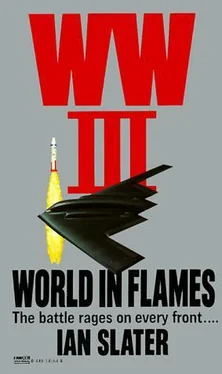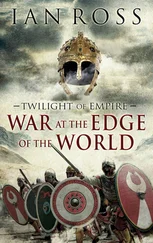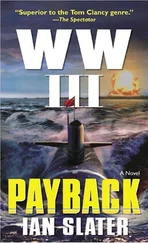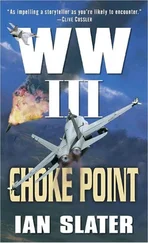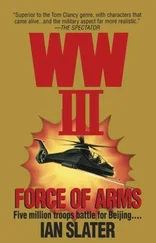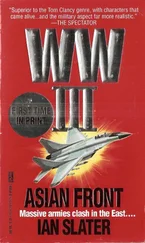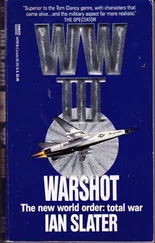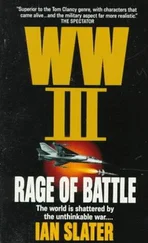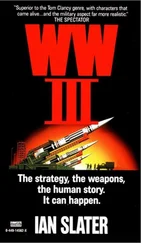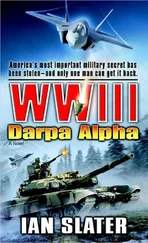The Mark-98 missile firing control system was all systems go, except for tube three, whose humidity control had gone haywire during the severe vibration.
Beneath the hum of the missile verification sequence, they could hear the steady roll of the VLF drum unwinding the antenna that would trail for over a thousand feet behind them if the hole in the ice was wide enough.
After the missile verification procedures and sequences were completed, Brentwood inserted his key to complete the circuit. The gas/steam generator ignited the small exhaust rocket at the base of number one tube. The sudden buildup of steam pressure from the rocket pushed the missile out of the tube, the blue protective membrane cap atop the tube shattering concentrically, the missile rising above the fairing of the pressure hull. The solid propellant of the first-stage booster ignited, the missile’s needlelike aerospike, which would extend its range if necessary, slid out of the nose, the missile now clearing the surface of the ice-free hole, back-flooding beginning immediately, the weight of the sub decreasing, the sub rising as the first ICBM burst clear of water, its orange tail flattening momentarily on the sea-air interface, its feral roar heard in the sub, and soon seen on radar screens all over the world, including those in SAC and on the Kola Peninsula, rising high over the vast ice cap in as straight a trajectory as could be attained, then falling back, crashing immediately, clearly unarmed, onto the ice pack and disintegrating.
This was followed by the second missile, lightening the Roosevelt further and also viewed on the radar screens of both sides as, unarmed like the first, it went up and fell in like fashion, crashing harmlessly into the ice miles from the Roosevelt, which was now broaching. Bursting through the ice hole in the Arctic Sea, the sub was hidden in a frenzy of gossamer white, her bow angle at forty-five degrees, water streaming off her into the churning sea, made more turbulent by the fierce bubbling of the torpedoes exploding a half mile away, breaking the spine of a Rubis-class Hunter/Killer, a French nuclear sub that had attacked Roosevelt after failing to get either prop or cavitation matchup because of Roosevelt’s damaged prop, the French sonar operator, running blind with only sound to guide, having misidentified the American Sea Wolf as a Russian Alfa.
* * *
Within five minutes of the Roosevelt’s surfacing, her VLF aerial was receiving the message from the E-6A TACAMO aircraft out of Reykjavik, Iceland, informing her that limited chemical and nuclear war had broken out in Korea and that “nuclear engagement” might soon occur on the European front. With this in mind, the president had authorized retaliatory strikes should the Russians… The message broke off, then resumed a few seconds later as Murmansk launched three ICBMs on North American trajectories despite the fact that Murmansk HQ, as they had seen clearly on their radar screens and as the TACAMO aircraft had advised them, knew that the Roosevelt’s ICBMs had not gone into intercontinental trajectory, had clearly been disarmed, and had been tracked to destruction on the ice cap. The TACAMO aircraft also advised the Roosevelt there was reason to suspect the Soviet leadership was in “disarray,” which, Zeldman pointed out, meant that no one knew who the hell was in charge of Moscow.
As suddenly as they had picked up the TACAMO message, it ended, the aircraft disappearing from Roosevelt’s sail-mounted radar. Instead, what they did pick up were the trajectories of the Russian ICBMs. Brentwood did not hesitate and ordered two of the remaining missiles, the mid pair — three and four — launched. Firing Control, however, could not get number three to launch, the tube’s humidity control having gone haywire during the severe vibrations. Number four, however, was fired successfully, its launch flame buckling the fairings about the tube hatches, increasing the temperature inside the sub by ten degrees in less than four seconds.
Soon the second of its three-stage boosters took over, the missile streaking into the stratosphere, its seven 330-kiloton warheads independently targeted on seven of Kola Peninsula’s major submarine and military bases. Even given a CEP— circular error probability — of plus or minus two thousand yards, the military targets, including the superhardened sub pens in Murmansk, chosen by Brentwood in retaliation for the Russian launch of the three SS-19 model 3s, were all certain to be destroyed.
* * *
Most of the Roosevelt’s crew had been evacuated to the ice through “charge-blown” exits through the hull. Their escape was so quick after the long, tension-filled hours behind them that for many, it had not yet sunk in. Yet leaving their submarine, despite the fact they had no choice, was an emotional affair. It was, had been, their home. They had made it so in a thousand little ways that, though conforming to regulation, permitted them to mark it with their singular and collective humanity. And now, in the gray darkness of the Arctic night, rugging up as best they could in their winter issue, they wondered if their fate on the ice cap would be any better than if they had gone down with the sub. For many submariners the sudden implosion of water was a better death than a lingering approximation of life.
It was a torpedoman’s mate who, assigned as one of the lookouts while the rest of the crew — first those who had been wounded during the Alfa attack — were taken off, first noticed what he thought were “ice piles” jutting up on the endlessly depressing horizon. He was reinforced in this interpretation by the fact that the ice was moving in all about them and locking Roosevelt in. But after several minutes he realized that what he had thought were four dots, moving too low for a radar pickup, were heading ominously toward Roosevelt. Shivering in the Arctic cold, the bridge knuckled with ice, the torpedoman’s mate was struck by the ultimate irony that the most powerful warship ever made now sat as helpless as a beached whale, the black dots no longer four but five.
As the Russian ICBMs, SS-19s, Model 3s — eighteen warheads in all — were being tracked on the big blue screens deep in Cheyenne Mountain, the mountain itself one of their targets, another being SAC HQ below Omaha, President Mayne stepped from the presidential helicopter at Andrews and boarded “Kneecap.” The 425-ton, 331-foot-long national emergency airborne command post aircraft, or “Doomsday” plane — piloted by Maj. Frank Shirer — was capable of staying airborne for seventy-two hours with refueling and with a ceiling of forty-five thousand feet.
As the 747 rose above the blue hills of Virginia, mobile microwave relay and booster stations were being aligned, while the phone network into which signals from the plane’s five-mile-long, 5/8-inch cable could be fed into the silos and other elements of the triad were being repaired.
From the line of twenty-eight stern-faced computer operators in Kneecap came the information that the targets of the seventeen missiles almost certainly included Cheyenne Mountain in Colorado, Omaha, Nebraska, the Trident SLBM sub bases at Bangor, Washington, Kings Bay, and the Trident tracking facilities at Point Magu in California and Cape Canaveral. The remaining eleven 550-kiloton warheads were expected to zero in on the MX silos in the Midwest.
The situation, bad as it was, became more terrible because of what General Carlisle, SAC’s commander, who had already launched Stealth fighter intercepts to fire “spoiler” rockets and B-1 bombers with cruise missiles, told the president in the last phone call he would ever make — that they were faced with the “old north/south problem.”
Читать дальше
